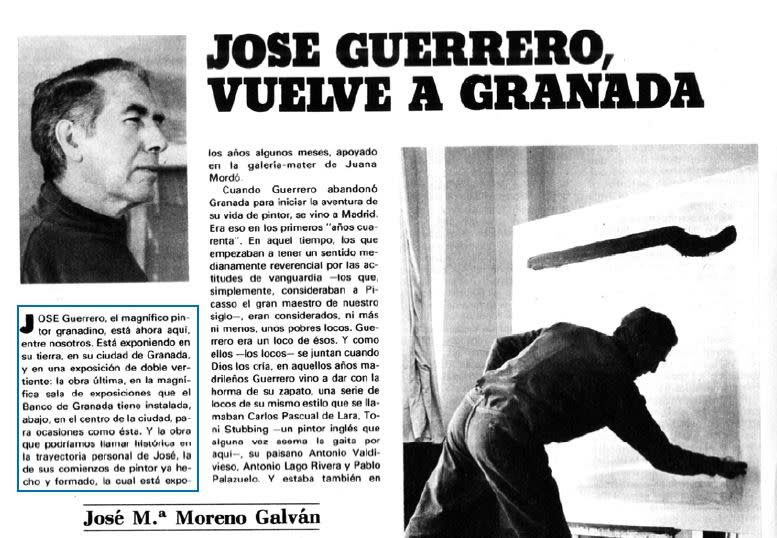Because Guerrero left Granada many years ago and, after exercising his trade in Madrid, at a very early time at the beginnings of the latest vanguard, he ended up in the United States and was resident in New York. Not long ago I talked with James Johnson Sweeney, the important American critic, about Guerrero’s work, which now occupies an important position in the vanguard of American art. There, Guerrero married Roxane, an adorable woman, and had children; there he has what is most important in his life and his connection with painting, but… But Guerrero has not abandoned and does not want to completely abandon his native land. […]
I do not know what the immediate motivations would be for Guerrero, after exercising professionally in Madrid and after the notorious time spent learning in Paris, to end up in the States and to settle in New York. The first news that I had about him was, many years ago, in a significant report –I think in “Life”– about new American painting. Who was this Guerrero, a painter from New York?, I asked myself at the time. Carlos Lara took it upon himself to fill me in on the details. More and more news then gradually arrived, until he himself came. From the early 50s, I believe that American painting has been one of the most influential in the José María Moreno Galván José Guerrero, vuelve a Granada (1976) 40 Historical Texts and Documents 41 Historical Texts and Documents world and Guerrero has established an important name for himself. […]
On entering the main room of the Art Gallery of the Banco de Granada, I was immediately dazzled by the celebration of colour which Guerrero’s exhibition represents but, afterwards, looking at it all more reflectively, I was surprised by the joyful freedom with which all this painting is regarded… So much so that –I think in an initial hasty consideration– the first of Guerrero’s great qualities as a painter is that of his freedom as such: the quality of “being a painter” without self-limiting restrictions –so common to so many creators of his kind–, this impetuous surrender to the clear word of the painting which characterizes the work of our artist. I have never seen Guerrero the painter paint, but I can feel it. I feel his overwhelming impetus, always pressured and urged by the pictorial word which –I believe– emerges relentlessly from his brush. I think that, for Guerrero, painting is a pantheistic celebration in which each colour already printed demands the colour which complements it and each shape demands a new shape…
Guerrero is a painter “by the grace of God”. I believe that he has an almost “animal” instinct about painting, which makes him identify with it in solidarity: so much so that, frequently, he is the blue that he paints or the red that is nervously printed on the canvas. It is difficult –have I already said this some time?– to find in the whole panorama of our painting a painter who is such a painter, so identified –will the word be understood in the exact sense which I want to attach to it?– a painter so animally identified with the function of painting. Guerrero paints and, of course, uses colours and shapes… But the use of these shapes is rarely influenced so much, rather than by the shapes themselves, by the superior motives of painting… The colour… How far from the impressionist colour of the old masters! With Guerrero, colour exists in its own right. It does not depend on any light which has to be transformed into a chromatic effect, or on any translation of phenomena or coloured objects. His colour is always autonomous and, therefore, has the strength of things aware of their own value. Sometimes, with this energy characteristic of Guerrero’s painting, he takes a colour and maintains it across a whole shape or large surface, the shape never tiring with the repetition of the same chromatic temperature across a large dimension. Without ever tiring. I find that one of Guerrero’s great qualities as a painter is based on this, his pictorial amenity.
I went to the exhibition of Guerrero’s current work from the other exhibition, from that of his work which we could call “historical”. And I believe that they complement each other. Rather than complementing each other, they confirm each other. The previous work confirms and supports the current painter and makes us aware that it is not improvised. To obtain work like Guerrero’s current pieces, it was necessary to forego a great deal. Expertise involves giving up many things. But you can only forgo what has already been previously achieved. Seeing Guerrero’s two complementary exhibitions, you realize how much has to be left on one side of the path to pictorial mastership in order to be able to truly achieve this mastership. But you also realize how much it is necessary to learn to be able to forget all learning.




